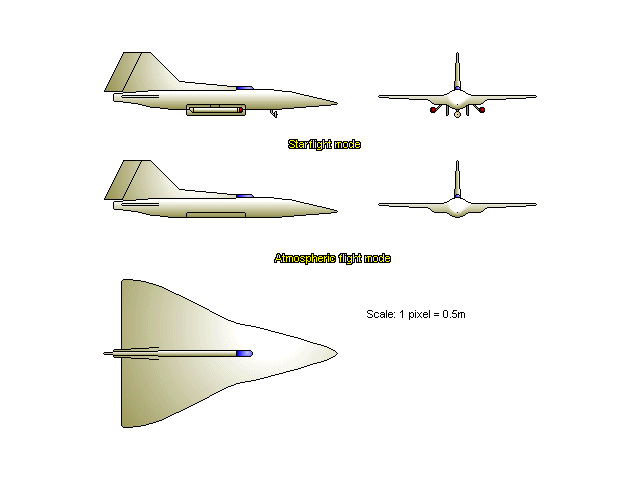

Chapparral class light exploration cruiser
Inscription on Commissioning Plaque:
"The fact that some geniuses were laughed at does not imply that all who are laughed at are geniuses. They laughed at Columbus, they laughed at Fulton, they laughed at the Wright brothers. But they also laughed at Bozo the Clown."
-- Carl Sagan
General Specifications:
Length: 117m
Width: 79.5m
Height: 32.5m (warp drives extended); 29m (warp drives retracted)
Emergency Warp: 5.0
Cruise: Warp 4.5
Max Impulse: 0.32 lightspeed
Crew: 35
Armament: One laser cannon (fwd); a focussing coil enabled the fusion exhaust of the impulse drive to be used as a short-ranged weapon, with a range of approximately 3,000 km.
Type: Light exploration cruiser
Status: 51 Chapparral cruisers constructed between 2160 and 2167. Chapparrals entered Starfleet service in 2161 and served until 2218. Of the 51 produced, 32 are missing, and 2 were destroyed. The remainder were demilitarized and sold as transports.
About Ship: The Chapparal was intended to be the next generation of exploration cruisers to follow the Daedalus. It's primary mission was to scout ahead of the Daedalus cruisers, identifying star systems that contained class M planets, rare resources, or other items of interest. The intervention of the Romulan war forced UESPA to re-think the concept, forcing a partial redesign before it entered production.
The Chapparral was designed to operate both as a scouting vessel and an explorer. As the design was too small to carry a practical landing craft, it was equipped with aerodynamic surfaces, auxiliary VTOL engines, and landing jacks to enable it to land directly on a planetary surface. The stardrive mechanisms, specifically the warp nacelles and the navigational deflector, were designed to retract during atmospheric operation to avoid damage from atmospheric friction.
The Chapparral's change in mission required it to operate as a long-ranged exploration vessel in its own right. Hull length was stretched by 15 meters to allow for additional fuel storage and equipment that would allow the Chapparral to dive into the upper atmosphere of a gas giant to replenish it's deuterium supply. This would extend the range, as more antimatter could be carried from the start, but would also neccessitate frequent stops for additional deuterium, a factor which may account for the high loss rate of this type.
The original Chapparral design was unarmed, and carried minimal sensors. The redesigned vessel carried a forward-firing laser, and was equipped with a focussing coil to allow it to use its fusion exhaust as a short-ranged weapon. It was neither as fast at sublight nor as well-armed as the Romulan Thunderbird, which was approximately the same size, but it was considerably faster at warp than any known Romulan vessel. It was even faster than the Borchardt, which had been the fastest ship in the fleet until the Chapparral was introduced.
The main sensors were the most sophisticated sensors yet to be mounted in a starship up to that time, and were mounted within the vertical stabilizer and on the upper surfaces of the wings. This allowed the vessel to scan perpendicular to its course, but was not very effective along the line of travel. Sypplementary sensors were mounted in the nose section to scan ahead of the ship.
Chapparral crewmembers were convinced that it was the finest vessel in the fleet. When the Federation initiated first contact with the Klingons in 2218, with disastrous results, it was felt that a vessel with such an unimpressive armament coupled with a puzzlingly high loss rate no longer had a place within the fleet. All remaining Chapparrals were recalled from service, demilitarized, and sold to civilian concerns as transports.
Return to Ships Starfleet Never Built Main Menu